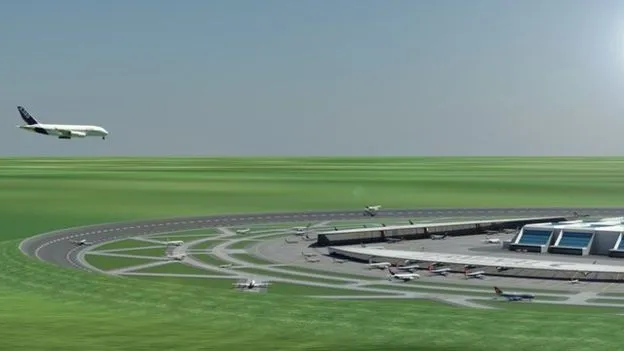
Circular runway plan poses questions
Jul 04, 2017

A circular runway plan has emerged as a revolutionary concept in aviation, promising to enhance safety and efficiency. However, this innovative design raises several questions regarding its practicality and implementation. Concerns about the structural integrity of a circular runway, the complexity of takeoff and landing procedures, and the adaptation of current air traffic control systems need to be addressed. Additionally, potential impacts on noise pollution and environmental factors must be considered. As experts examine the feasibility of this idea, the aviation industry must weigh the benefits against the challenges that such a significant change would entail.
The concept of a circular runway is not just a novel idea; it represents a potential revolution in aviation design and airport operations. As urban air travel continues to grow, the traditional linear runways face limitations in capacity and efficiency. The circular runway plan poses questions about the future of aviation, particularly in terms of safety, design, and environmental impact. Let's explore these aspects in detail.
What is a Circular Runway?
A circular runway is an innovative design that allows aircraft to take off and land in a circular pattern rather than the conventional straight-line approach. This design can potentially increase airport capacity by allowing multiple aircraft to use the runway at the same time. Furthermore, it can reduce the need for long taxiways and minimize noise pollution in surrounding areas.
Potential Benefits of Circular Runways
Several benefits arise from the implementation of circular runways:
| Benefit | Description |
|---|---|
| Increased Capacity | Circular runways can handle multiple aircraft simultaneously, reducing congestion and improving efficiency. |
| Reduced Noise Pollution | By allowing for multiple takeoff and landing patterns, noise can be distributed more evenly, minimizing the impact on local communities. |
| Enhanced Safety | Circular designs can allow for better separation between aircraft during takeoff and landing, potentially reducing the risk of accidents. |
| Shorter Taxi Times | Aircraft can access the runway more directly, leading to shorter taxi times and reduced fuel consumption. |
Challenges and Concerns
Despite the potential advantages, the circular runway plan raises several questions and challenges:
- Engineering Feasibility: Building a circular runway involves significant engineering challenges. The structural integrity, surface materials, and drainage systems must be meticulously planned and executed.
- Regulatory Approval: Circular runways would require extensive regulatory reviews. Aviation authorities must evaluate their safety and operational effectiveness compared to traditional runways.
- Pilot Training: Pilots would need specialized training to operate in a circular runway environment. This could lead to increased costs and time in adapting to new procedures.
- Public Perception: Public acceptance of the circular runway concept will be crucial. Concerns about safety and effectiveness must be addressed through transparent communication and thorough testing.
Case Studies and Experiments
While the idea of circular runways may seem futuristic, there have been various experiments and discussions on this topic. For instance, concepts have been proposed in countries like the Netherlands and China, where urban areas face severe space limitations. These case studies highlight both the enthusiasm surrounding circular runways and the skepticism that accompanies such radical changes in aviation infrastructure.
Environmental Impact
One of the critical aspects of any new airport design is its environmental impact. Circular runways could potentially lessen the carbon footprint of air travel by:
- Reducing Fuel Consumption: Shorter taxi times and efficient takeoff and landing procedures can lead to lower fuel consumption.
- Lowering Emissions: By minimizing noise pollution and improving air traffic flow, circular runways can contribute to cleaner air quality.
However, comprehensive environmental assessments will be necessary to gauge the overall impact of such designs on local ecosystems.
The Future of Circular Runways
The future of circular runways is still uncertain, but the dialogue surrounding them is essential. As cities grow and the demand for air travel increases, innovative solutions like circular runways may become more viable. The aviation industry must weigh the potential benefits against the challenges posed by this design. Engaging with stakeholders, including airlines, airport authorities, and local communities, will be crucial in determining the feasibility of circular runways.
Conclusion
In conclusion, the circular runway plan poses intriguing questions that could reshape the future of air travel. While the potential benefits are significant, the challenges must not be overlooked. As we move towards a more sustainable and efficient aviation system, concepts like circular runways deserve serious consideration. The key will be to find a balance between innovation, safety, and community acceptance, paving the way for a new era in airport design.
Related Articles

Explore Thailand: The Best Islands to Visit for Paradise, Adventure, and Relaxation

The Ultimate Guide to the Best Islands in Thailand for Your Next Getaway

Do babies need passports? How to get a passport for a newborn

How to get a U.S. passport fast: here’s how to expedite the process

What is Mobile Passport Control: 5 reasons why you should use it

SENTRI vs. Global Entry: A detailed guide

Do you need a passport to go to the Bahamas? Let’s find out

Do you need a passport to go to Mexico? A detailed guide

Do you need a passport to go to Canada? We got the answer

Do You Need a Passport for a Cruise: An Essential Travel Guide

Booster Seat Requirements: All the Rules to Follow in Your Rental Car

What Are the World’s Most Powerful Passports, and How Does Yours Rank?

How to Take a Passport Photo at Home: A Helpful Guide

You've got to have heart! Southwest's new livery

Your opinion: Should water be free on low cost carriers?

Young women bolder than guys as solo travellers
